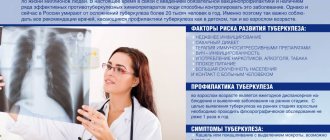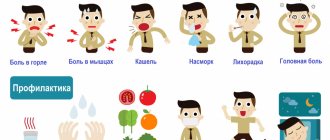Most often, a person becomes acquainted with viruses and bacteria during the cold season. Acute respiratory infections are one of the most common diseases in the world. Most of these diseases occur due to viruses and bacteria that enter the human body along with inhaled air and settle on the mucous membranes of the nose or mouth1.
To understand the infection process, we can give an analogy with any public institution, which in our case is the human body. Through open doors, various guests - viruses and bacteria - enter the establishment. Some bacteria are intelligent people and do no harm, while some are strictly prohibited from entering: they can provoke a real conflict. As for viruses, these are, for the most part, bandits. You shouldn't expect anything good from them.
There is a security system against undesirable persons outside and inside the establishment - human immunity. Sometimes the immune system does not cope with its tasks, gets tired or is “distracted” by bacteria, allowing dangerous viruses to enter, which immediately begin a raider takeover.
So what is the main difference between them? First, you need to clearly understand what they are, and based on this, determine the difference and the principle of their effect on the body.
What are viruses
A virus is a tiny organism that can exist and reproduce only inside living cells. In the external environment, the virus is found in microparticles of biological material, but multiplies exclusively in the cells of living beings. In other words, the virus is not active until it is inside a person2.
And he gets there like this:
- Airborne, like most respiratory infections
- When drinking dirty water, with food, or not following hygiene rules
- From mother to unborn child
- Contact – in close contact through the skin or mucous membranes
- Parenterally - bypassing the gastrointestinal tract, by injection
After entering the body, the virus first attaches to the cell, then delivers its biological genome into it, loses its envelope, and only then multiplies. After reproduction, the virus leaves the cell, and the infectious agent spreads along with the blood, continuing total infection. Viruses can suppress the immune system2.
Taking medications
It is important to take antibiotics in the presence of bacteria, when treating a virus - they do not have the desired effect. The only option for accurately determining the type of infection is to see a doctor. He will remove a particle of mucous membrane secretions or a throat swab and take it to the laboratory. If the doctor realizes that you need antibiotics, he will convince you of the presence of bacteria.
You can buy pain relief medications without a doctor's prescription.
If you have severe pain with both infections, talk to your pharmacist about the medications that are right for you.
If your doctor prescribes antibiotics, ask him if you can take painkillers at the same time. You should also get a flu vaccine. To prevent a recurrence of the flu, you need to get vaccinated. This way you will protect yourself from the influenza virus.
What are bacteria
A bacterium is a complete, albeit single-celled, organism. It can reproduce through division, which is what it actively does in nature or within humans3.
Not all bacteria cause infectious diseases. Some are beneficial and live in the organs of the body. For example, lactic acid or bifidobacteria, which live in the intestines and gastric tract, are actively involved in human life and actually form part of his immune defense3.
The entry of bacteria into the body follows the path of viruses. But bacteria multiply more often outside the cell than inside it. The list of diseases that develop as a result of their penetration into the human body is extremely long. Bacteria can cause3:
- Respiratory diseases (most often caused by staphylococci and streptococci)
- Gastrointestinal infections (caused by Escherichia coli and enterococci)
- Damage to the nervous system (sometimes caused by meningococci)
- A number of diseases of the reproductive system, etc.
By multiplying, they spread through the bloodstream, which leads to generalization of the infection and clinical worsening of the patient’s condition. Bacteria can also suppress the immune system, making it harder for the body to resist viruses3.
Bacterial infections
A bacterial infection can occur on its own or as a result of a viral infection. “Viruses, by breaking the protective barrier and suppressing the immune system, create a favorable environment for the proliferation of bacteria. As a result, bacterial complications arise - sinusitis, laryngitis, tonsillitis (sore throat), otitis media, tracheitis, bronchitis or pneumonia,” says Nikolai Lutsevich.
How to treat a bacterial infection
Bacterial infections are treated only with antibiotics. “The prescription of antibacterial drugs is mandatory, otherwise the body may not be able to cope with the disease on its own. The antibiotic should be selected by the attending physician,” the specialist emphasizes. Nikolai Lutsevich notes: if after two or three days of symptomatic treatment a person does not feel better, he should consult a doctor.
“Sometimes only the attending physician can guess whether it is a virus or a bacteria. Let me give you an example of a red throat. Each person perceives this symptom differently. And this is a signal for several diseases.
Plaque on the tonsils can be due to mononucleosis, sore throat and candidiasis. The first option is treated with antiviral drugs, the second with antibiotics, and the third with antifungal drugs. Therefore, it is better to entrust the treatment of the disease to a specialist,” emphasizes the head of the infectious diseases department.
How does a virus differ from a bacterium?
Thus, both viruses and bacteria are capable of infecting the body, causing infection. The key difference between them is in the reproduction mechanism. Viruses cannot reproduce in the external environment, so they need to invade the cell. Bacteria reproduce by division and can live in the external environment for a long time, waiting to enter the human body. Accordingly, the mechanisms for antibacterial and antiviral protection should also differ4.
Let's summarize briefly. The differences between a virus and a bacterium are as follows:
- Size and form of existence. A virus is the simplest life form, a bacterium is a single-celled living creature.
- Life activity. The virus exists only inside the cell and infects it, after which reproduction (cloning) occurs. The bacterium lives a full life, reproducing by division, and the body for it is only a favorable place of existence.
- Form of manifestation. Viruses tend to manifest themselves by increased body temperature, general weakness, muscle and joint pain. Bacteria manifest themselves as unhealthy discharge (purulent or as a specific plaque).
Typical viral diseases: ARVI, influenza, herpes, measles and rubella. These also include encephalitis, hepatitis, smallpox, HIV, etc.
Typical bacterial diseases: syphilis, whooping cough, cholera, tuberculosis, diphtheria, typhoid and intestinal infections, STIs.
It happens that both of them cause one disease together. Such a symbiosis requires special treatment. Examples include: sinusitis, tonsillitis, meningitis, pneumonia and other diseases5.
University
→ Home → University → University in the media → How to distinguish a bacterial infection from the flu, who should wear a gauze bandage and when
A common cold? Not so simple!
How to distinguish a bacterial infection from the flu, who should wear a gauze bandage and when, and what antiviral drugs can be prescribed at the height of the disease?
Questions about ARI were answered by a general practitioner, head of the Department of Polyclinic Therapy of BSMU, Candidate of Medical Sciences. Sciences, Associate Professor Elena Yakovleva.
— People distinguish between colds and flu. In the professional medical environment, the terms “flu”, “ARI”, “ARVI” are used. What is the connection between them?
— Colds are commonly called acute respiratory infections (ARIs). This is a group of clinically similar acute infectious diseases, transmitted primarily by airborne droplets, which are caused by respiratory viruses, bacteria, mycoplasmas, chlamydia and are characterized by inflammation of the mucous membrane of the respiratory tract with varying severity of symptoms of general intoxication.
The causative agents of ARVI can be more than 200 different representatives of four families of RNA viruses: orthomyxo-, paramyxo-, corona-, picornaviruses; as well as two families of DNA-containing viruses - adeno- and herpes-.
Because of this diversity, both preventing and treating these diseases is challenging.
The main place among ARIs is occupied by acute respiratory viral infections (influenza, parainfluenza, adenovirus, rhinovirus, coronavirus, enterovirus, etc.), designated by the general term ARVI, as well as mycoplasmas, chlamydia, bacteria, their various associations (viral-viral, viral-bacterial , viral-mycoplasma), which complicate the course of the disease.
Thus, a kind of “matryoshka doll” is obtained: influenza is classified as ARVI, and ARVI is included in ARI.
“Everyone is afraid of the flu, but they consider the cold to be a minor illness and therefore often carry it on their feet...
— Ignoring medical care and self-medication for any form of respiratory infections can be costly: the recovery period is delayed, more dangerous diseases (sore throat, sinusitis, pneumonia, etc.) often remain undetected, complications arise, and conditions are created for infecting others.
— What tests do a patient with ARVI symptoms need?
— The mandatory examination plan includes general blood and urine tests. They should be carried out on the 3rd–5th day after the temperature has returned to normal in order to verify complete recovery.
If there is a suspicion of a bacterial infection, complications have developed, tests are sent on the 1st–3rd day of the disease, and, if necessary, an electrocardiogram, chest x-ray, biochemical blood test, etc. are prescribed.
— Is it possible to determine from the symptoms that it is the virus that has settled in the body?
— The flu has a peculiar course: it is characterized by an acute onset, the temperature stays above 38 ° C for 4–5 days, chills, muscle pain, lacrimation, headache in the frontotemporal region, at the brow ridges, as well as in the eyeballs (so-called retro-orbital pain, which appears when moving the eyes). General weakness, weakness, sweating are noted; Possible vomiting and nosebleeds. On the 1st–2nd day, the symptoms of intoxication are accompanied by catarrhal syndrome: rhinitis (nasal congestion, light serous or mucous-serous discharge); dry painful cough.
The clinical picture for different pathogens has its own characteristics. One of the indicators is the location of the source of inflammation. Parainfluenza, as a rule, causes laryngitis, adenovirus - conjunctivitis and damage to lymphoid tissue, respiratory syncytial virus - bronchiolitis.
You can distinguish the manifestation of viruses and bacteria by the nature of the discharge. If when you cough, the sputum is purulent and the same discharge from the nose, this indicates the activity of bacteria. In viral infections, the discharge is usually mucous.
— What are the laboratory signs of viral or bacterial activity in ARI?
- With bacterial inflammation - leukocytosis, band shift in the leukocyte formula, increased ESR. In uncomplicated ARVI, there are no changes in the general blood test or there is leukopenia, neutropenia, moderate lymphocytosis and monocytosis, and the ESR is normal.
If ARI is severe and the patient is being treated in a hospital, the biomaterial is examined to determine the specific pathogen (polymerase chain reaction, enzyme immunosorbent assay, direct immunofluorescence).
- Feeling unwell, many try to do something - drink tea with lemon, go to bed, and some take medicine. Are there safe and effective schemes for such self-help at the initial stage?
— Any non-drug method has a right to exist. A doctor must prescribe medications. The local doctor knows the allergy history, the presence of concomitant diseases and will select individual comprehensive treatment.
It is best to discuss with a specialist the possibility of taking antipyretic, antiviral, and vitamins before the incidence begins to rise. Not only the correct choice of drug is very important, but also its dose, as well as the frequency of administration.
— What are the indications for prescribing antibiotics, antiviral, antipyretic drugs?
— Antibiotics should only be used to treat bacterial infections. For ARVI - in exceptional situations: age over 60 years; there is a suspicion of pneumonia; history of chronic rheumatic heart disease; long-term bed rest (in disabled people, patients in trauma departments, etc.). In these cases, broad-spectrum antimicrobial agents are used.
Antipyretics are required at body temperatures above 38.5 °C.
Antiviral drugs are currently a heterogeneous group of drugs. Among them there are drugs characterized by a selective effect (effective against a specific virus) - an adamantane derivative (rimantadine) and selective neuraminidase inhibitors (oseltamivir and zanamivir), and there are non-selective ones - interferons (human leukocyte interferon (interferon alpha), influenzae (interferon alpha 2b), inducers of endogenous interferon (arbidol, hyporamin, kagocel, anaferon, ergoferon, tiloron, ingavirin, enisamium iodide, inosine pranobex, etc.), affecting a number of viruses. In the last decade, the number of non-selective drugs has sharply increased due to expanding the spectrum of endogenous interferon inducers.
Selective antivirals are prescribed on the first day of the disease, while non-selective antivirals can be started at a later date.
— Are all ARIs equally infectious to others?
— Contact with a sick person does not necessarily result in infection. The general level of human health, especially the state of his immune system, is of great importance.
The potential “infectiousness” depends on the duration of the virus shedding from the patient. With the flu, it is better not to communicate for 7 days after the first symptoms appear, with parainfluenza - 3-10 days, adenovirus - up to 25 days, respiratory syncytial virus - 7 days, rhinovirus - 2-3 days.
— Even when the incidence level has not been exceeded, some people wear gauze bandages. Is this justified?
— We observed widespread wearing of gauze bandages during the 2009–2010 season, when the H1N1 pandemic flu was widespread. They were even used on the streets, which is unreasonable.
Masks should be used primarily by those who are sick to protect others. For healthy people, wearing masks is practical in crowded places (shops, clinics, transport), as well as when in contact with sick people. Both disposable ones, purchased at a pharmacy, and those made independently from gauze are suitable (preference should be given to those made from non-woven materials).
It is important to follow several rules:
• the mask must tightly cover the mouth and nose, leaving no gaps;
• do not touch it with your hands;
• a wet or damp mask should be replaced with a new, dry one;
• change the mask every 2 hours (throw away the disposable one, wash the reusable one). Elena Kleshchenok Photo: Gennady Sukach Medical Bulletin , January 24, 2017
Share
Fighting viruses and bacteria
It is impossible to completely protect yourself from viruses and bacteria. A person is constantly attacked by a huge number of microorganisms and the main barrier to their path is immunity. Therefore, it is important to strengthen and keep the immune system in a “fighting” state, especially during the cold season and during periods of seasonal diseases.
The immunomodulator IRS®19 will become an assistant on the path to a healthy and strong immune system. It contains a mixture of bacterial lysates, which are specially isolated parts of pest bacteria. Lysates activate the immune system and direct it to fight bacteria and viruses. The drug has a high level of safety and can be prescribed to prevent infections in adults and children over 3 months of age. It has been tested many times and has shown excellent results in the fight against infections, including ARVI6.
Diagnostic features
A biochemical blood test allows you to determine the level of red blood cells, platelets, leukocytes and hemoglobin. The analysis reveals the leukocyte molecule and the rate of red blood cell coagulation. The type of infection depends on this.
Antimicrobial therapy does not affect viruses, so taking antibiotics for flu and colds is pointless. Perhaps they will turn out to be harmful in this case, because they kill not only harmful, but also beneficial microparticles that half create the immune system. And if bacteria are present, it is very important to take antibiotics, otherwise the immune system will not cope and the disease will become chronic. Here are the differences between a virus and an infection . But despite this, sometimes the doctor recommends the same treatment regimen. Usually this approach is effective in treating children: even with the slightest virus, you need to take antibiotics. After all, the baby’s body is very weak, and bacteria usually connect to the virus, so taking antibiotics is justified.
At our EL Clinic in Butovo, you can undergo a comprehensive examination to detect a viral or bacterial infection. After determining the results, qualified specialists will create an effective treatment plan.
Stretch your immune system
What determines our susceptibility to infection? Why, under equal conditions, does one person get sick every now and then, while the other gets absolutely nothing? It's all about immunity and the body's ability to resist “dark forces” in the form of microorganisms. “The work of the entire human body depends on the immune system,” comments Viktor Lenshin . — Even negative thoughts can reduce the body’s protective functions. Are you nervous? Are you worried? Are you afraid of something? The body senses everything and begins to react. Nothing kills the immune system like fear. However, you should take immunostimulating drugs only on the recommendation of a doctor. Are constant human encounters with viruses and bacteria dangerous? No, the immune system must constantly work and train in order to repel any attack in case of danger. In this regard, sterile conditions are much worse for the body. Although, of course, you should not overestimate your own resources, and during flu epidemics, do not neglect precautions and at least wear a simple gauze bandage.
| Signs of a viral infection: - Increased body temperature; -muscle pain; -cough, sneezing, runny nose; -chills; -diarrhea, vomiting; -skin rash; -feeling of weakness. | Signs of a bacterial infection : -fever; - pain in any one part of the body; -enlarged lymph nodes; -suppuration; -lack of appetite; -nausea, vomiting; -sweating. |
| Main viral infections : -colds (ARVI, influenza, etc.); - intestinal viruses (viral gastroenteritis); - hepatitis virus; -herpes virus; -human papillomavirus; -tuberculosis. | Main bacterial infections : - group A streptococcus (causes sore throat); - bacterial sinusitis and pneumonia; -salmonellosis. |
In search of the virus
In the endless struggle of man against viruses, it is still a draw. While scientists are creating defense mechanisms against infections, viruses are not bored either - they are developing, learning to overcome new barriers. An example of evolution is obvious. Most often, a person encounters viruses that lead to colds (herpes, ARVI, influenza), intestinal infections, hepatitis, and papillomavirus. We do not live in a sterile laboratory, so all kinds of microorganisms await us at every step. If your immune system weakens at some point, the virus breaks through the body’s defenses, and now you’re lying in bed with a high fever, body aches and a headache. These are the main signs indicating the presence of an intracellular “agent” in the body.
“A virus is a pure parasite that cannot reproduce without other cells,” explains Victor LENSHIN, epidemiologist, director of the Elisa diagnostic center. “It penetrates the cell and forces it to produce copies, since it does not have its own structure for independent reproduction and cannot copy itself. What happens to the cell? Most often, she dies and symptoms of the disease appear. A person is most susceptible to viral infections - herpes, acute respiratory viral infections and influenza are in the first positions in this ranking. However, our body has been familiar with them for a long time and fights very successfully.
Differences between viral and bacterial infections
- Mucous discharge. The viral pathogen is characterized by liquid, transparent discharge. With a bacterial infection, the discharge is thick and colored - green or brown with streaks of blood (with sinusitis).
- Temperature. With a viral infection, the temperature rises immediately. It lasts for several days and then decreases. With a bacterial infection, the temperature increases over several days.
- The source of the lesion. With a viral infection, everything hurts: throat, nose, head, general weakness and malaise. With a bacterial infection, a person can say exactly what is bothering him: a sore throat with a sore throat, bursting pain in the sinus area with sinusitis, chest pain and cough with bronchitis or pneumonia.
- Duration. With a viral infection, improvement occurs within 5-7 days. In case of bacterial infection, there is still no positive dynamics at this time.
Prevention and protection measures
Viruses spread in different ways, depending on their classification and characteristics. Hepatitis C, a liver disease, is transmitted through body fluids. On the other hand, the flu can be spread by contact with the virus left on an object, such as a phone, or through droplets in the air if someone with the flu sneezes or coughs in front of you. Not all viral infections can be prevented, but you can reduce your risk of contracting the virus in several ways:
- regularly vaccinate against viral infections;
- wash your hands frequently;
- avoid contact with sick people;
- Do not give personal items to anyone (toothbrushes, razors, manicure accessories).
Article sources:
- Laboratory diagnosis of congenital viral infections. Nisevich L.L., Bakhmut E.V., Ashirova A.A., Medzhidova A.A., Kushch A.A., Konopleva T.N., Talalaev A.G., Kask L.N., Parsegova T. S.S., Tumanova E.L. Children's infections, 2006. p. 12-18
- A new look at latent viral infection. Filatov F.P., Shargunov A.V., Blinov V.M. Hematology and Transfusiology, 2014. p. 28
- Improving the diagnosis of herpes viral infections. Vasiliev A.N., Fedorova N.E., Klimova R.R., Adieva A.A. Clinical laboratory diagnostics, 2012. p. 52-55
- Features of immunosuppression in viral infections. Churina E.G., Urazova O.I., Novitsky V.V., Naslednikova I.O., Voronkova O.V., Slepicheva N.R. Bulletin of Siberian Medicine, 2009. p. 112-118
- Influenza and acute respiratory viral infections. Selkov S.A. Infection and immunity, 2021. p. 216
- ACUTE RESPIRATORY VIRAL INFECTIONS AND THE HEART. Kirichenko A.A. Consilium Medicum, 2021. p. 22-27









